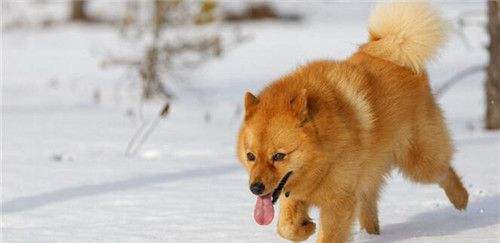Finnish Spitz
IUCN
LCBasic Information
Scientific classification
- name:Finnish Spitz
- Scientific Name:Suomenpystykorva
- Outline:Carnivora
- Family:Canidae
Vital signs
- length:39-50cm
- Weight:14-22kg
- lifetime:12-15year
Feature
Looks like a fox, Finland's national dog
Distribution and Habitat
Originated from Finland
Appearance
The mouth is prominent, the eyes are black and bright, and the ears are erect. The neck is short, the chest is deep, the abdomen is tight, the muscles are well-developed, and the tail is curled on the back. The coat is yellow or red, and sometimes there are white spots on the chest and feet.
The coat color is like fox fur: fiery red, golden red, etc. Fiery red, golden red and orange red are the typical coat colors of Finnish Spitz. White markings on the chest and sporadic black coats on the back are allowed. The coat of Finnish Spitz is divided into two layers. The outer coat is long, hard and straight; the bottom coat is short, soft, dense, and close to the body.
Details
The Finnish Spitz is a medium-sized working dog. Its English name is "Finnish Spitz". In Finland, it is called "Suomenpystykorva". In the early days, it was called Finnish Bird Dog or Finnish Spitz. Now it is called Finnish Spitz. It is the national dog of Finland.

The Finnish Spitz is the national dog of Finland. Its historical origins can be traced back thousands of years ago, when the Finno-Ugric people migrated to central Russia. As multiple ethnic groups migrated to different regions, they bred dogs out of need and developed dogs of different bloodlines. One tribe migrated to the far north, where there are about 60,000 lakes separating each other. The Finnish Spitz emerged as a purebred dog and became a valuable asset for hunters.
Centuries later, more advanced transportation methods brought different ethnic groups and their dogs to settle here, and the original Finnish Spitz began to crossbreed with other breeds of dogs, and by 1880, it even showed signs of extinction. At that time, two hunters from Helsinki discovered purebred local dogs while hunting in the northern forests and learned about their many advantages. Through a series of efforts, this breed was saved from extinction. Hugo Zons, one of the many breeders, was directly involved in the breeding of the breed and worked for 30 years, later he withdrew from this work. Another pioneer, Hugo Sandburg, launched a protection campaign in 1890, but he never bred a Finnish Spitz himself. In 1891, the first Helsinki Dog Show was held, and Mr. Sandburg served as a judge, and on that historic day, 5 Finnish Spitz were awarded ribbons. With the advent of dog shows, the breed needed a series of standards, and thanks to Mr. Sandburg's successful promotion, the Finnish Kennel Club recognized the breed in 1892 and established standards based on his observations. In 1897, when the details of the standards were revised, the Finnish Spitz became the official name of the breed.
The Finnish Spitz first entered the UK in 1927, brought to Scandinavia by Mr. Edward Chichester along the hunting trails. An early British fan, Miss Kitty Ritson, helped to form a club for the breed, and the nickname "Finkie" was coined by her. The dogs soon became known in several countries, and by 1935 the breed was officially registered with the Kennel Club. Perhaps the most recognized British supporter is Mrs. Griselda Price, whose "Cullabine" ranks behind top champions worldwide.
Finnishman Ray Rita made the breed recognized by the Canadian Kennel Club, and the AKC recognized the Finnish Spitz and recorded it in the stud book in 1974. Ms. Jen Grete's dogs played an important role in promoting the popularity of the breed. Finnish Spitz breeding in the United States began in the mid-1960s, and the introduction of the breed is attributed to Henry Davidson in Minnesota and Alex Hassell in Connecticut. In September 1983, the breed was allowed to join the mixed breed category, and the AKC's board of directors registered the Finnish Spitz in the stud book on August 1, 1987. The breed is still a non-hound dog and obtained an AKC show license on January 1, 1988.
In Finland, it is still a working dog, just as it was in the early days. With its different barks and indications, it can guide the hunter to the location of the prey, and when the hunter approaches, it can point the prey with its head and snout. In the deep forest, it can find the ptarmigan (a relative of the wild turkey), and keep in touch with the hunter by voice at all times by sight, smell and hearing. It can search for prey from the bushes until the prey flies up to the branches, then the dog will make a sound, which is very soft at first and gradually becomes stronger, to warn the owner to shoot the prey down. When it approaches the prey, it will constantly wag its tail, move back and forth, and bark to distract the bird. In Finland, the hunting ability of the breed is highly praised, so when it shows its value in this field, it will definitely win the championship in the competition, especially important for its barking ability, and it is selected as the king of barking every year.
In addition to its own country, the Finnish Spitz is mainly used as a family dog, a loyal companion, especially loved by children.
Protect wild animals and eliminate game.
Maintaining ecological balance is everyone's responsibility!








